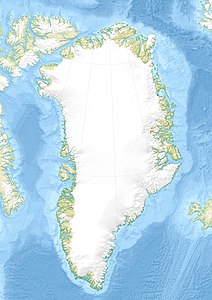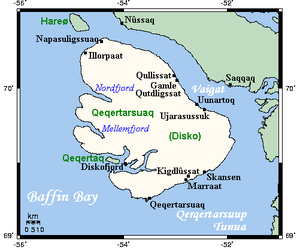Disco island
| Disco island | ||
|---|---|---|
| Satellite image | ||
| Waters | Disko Bay ( Baffinbai ) | |
| Geographical location | 69 ° 48 ′ N , 53 ° 21 ′ W | |
|
|
||
| length | 160 km | |
| surface | 8th 578 km² | |
| Highest elevation | 1919 m | |
| Residents | 892 (2015) <1 inh / km² |
|
| main place | Qeqertarsuaq (Godhavn) | |
| Disco island map | ||
The Disko Island ( Kalaallisut : Qeqertarsuaq , German "big island" ) with an area of 8578 km² (for comparison: Mallorca 3640 km², Corsica : 8680 km²) is about 60 kilometers west of Ilulissat (Jakobshavn) off the west coast of Greenland in Disko Bay (Qeqertarsuup Tunua). It is separated from mainland Greenland by the Vaigat .
geography
The mountain ranges that were formed 55 to 65 million years ago are made of reddish basalt , the highest point is 1919 meters, the average height is 975 meters. The island's permafrost only allows for tundra vegetation; there are no agricultural areas or trees. The interior of Disko Island covers a considerable part of the 918 km² Sermersuaq (ie "Great Glacier"). The Bræpasset ice cap extends over 254 km². Above Qeqertarsuaq lies the smaller Lyngmarks Glacier. A total of 19% of the island's area is glaciated.
There are three large fjords on the west coast, from north to south:
- Nordfjord (Kangersooq)
- Mellemfjord (Akulliit)
- Diskofjord (Kangerluk).
The disco island is very sparsely populated, there are only two permanently inhabited places. The largest settlement is Qeqertarsuaq (Godhavn) with 871 inhabitants (as of 2015) in the south. About 35 kilometers north of it is the still very original Inuit settlement Kangerluk with 21 inhabitants (as of 2015) who live from hunting and fishing. Until 1972 there was a coal mine in the north-east of the Qullissat miners' settlement , which formed its own municipality under the name Vaigat . However, after the mine was closed , residents were relocated to Ilulissat and Qeqertarsuaq, and the area of Vaigat Municipality was incorporated into Qeqertarsuaq .
Disco Island is interesting because of its geological formations interspersed with fossils . From a mineralogical point of view, the island is famous as it is one of the few places where terrestrial solid iron can be found. A basalt on the island that has penetrated the tertiary brown coal seams contains the iron in the form of large masses down to small tinsel. The largest known mass of iron has a weight of about 25 tons.
history
Traces of the Paleo-Eskimos and the Dorset culture were found near Qeqertarsuaq, but whether a permanent settlement already existed at that time is still a matter of dispute. In the immediate vicinity, near Ilulissat , the important settlement place Sermermiut of the Saqqaq culture was excavated. It is therefore very likely that Proto-Inuit peoples regularly visited Disco Island in prehistoric times.
Erik the Red is considered the first European to see Disco Island . North of the Arctic Circle there were no permanent settlements of the Greenlandic Vikings , but they did visit the area around Disko Bay in the summer months for hunting and named the region Norðrsetur .
In search of the legendary Northwest Passage , the ships HMS Erebus and HMS Terror of Sir John Franklin's expedition anchored in the bay off Qeqertarsuaq on July 4, 1845 to take in fresh water again. With the exception of a brief sighting by a whaler on the high seas, just a few days later, this was the last time that the 138 expedition members were seen alive.
The Danish ARKTISK research station was established in 1906 as a scientific base station and has been part of the Natural Science Faculty of the University of Copenhagen since 1956 . The Danish botanist Morten Pedersen Porsild was its first director until 1946.
Individual evidence
- ↑ Disko / Qeqertarsuaq on the homepage of the Arctic Station of the University of Copenhagen , accessed on September 17, 2015
- ^ Jacob C. Yde: Greenland Glaciers outside the Ice Sheet . In: Vijay P. Singh, Pratap Singh, Umesh K. Haritashya (Eds.): Encyclopedia of Snow, Ice and Glaciers . Springer, Dordrecht 2011, ISBN 978-90-481-2641-5 , pp. 479 ( limited preview in Google Book search).
- ↑ Statistics Greenland (Ed.): Greenland in Figures 2015 . 2015, ISBN 978-87-998113-0-4 , ISSN 1602-5709 , pp. 9 ( stat.gl [accessed on September 18, 2015]).
- ^ Paul Ramdohr , Hugo Strunz : Klockmanns textbook of mineralogy . 16th edition. Enke , Stuttgart 1978, ISBN 3-432-82986-8 , pp. 397 (first edition: 1891).








